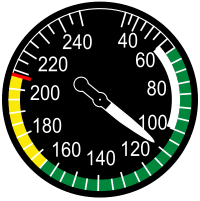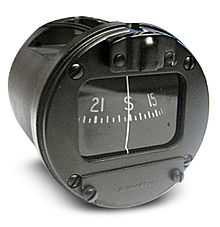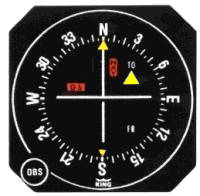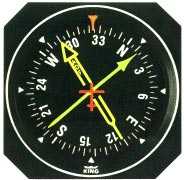Flight instrument
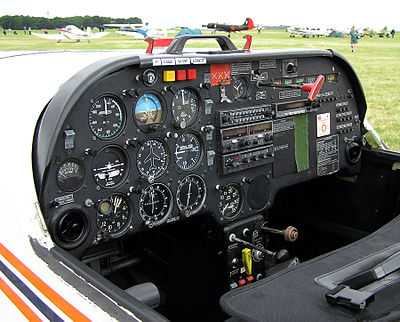
Flight instruments are the instruments in the cockpit of an aircraft that provide the pilot with information about the flight situation of that aircraft, such as altitude, airspeed and direction. The flight instruments are of particular use in conditions of poor visibility, such as in clouds, when such information is not available from visual reference outside the aircraft.
The term is sometimes used loosely as a synonym for cockpit instruments as a whole, in which context it can include engine instruments, navigational and communication equipment.
Many modern aircraft have electronic flight instrument systems.
Most regulated aircraft have these flight instruments:
Altimeter
The altimeter shows the aircraft's altitude above sea-level by measuring the difference between the pressure in a stack of aneroid capsules inside the altimeter and the atmospheric pressure obtained through the static system. It is adjustable for local barometric pressure which must be set correctly to obtain accurate altitude readings. As the aircraft ascends, the capsules expand and the static pressure drops, causing the altimeter to indicate a higher altitude. The opposite effect occurs when descending. With the advancement in aviation and increased altitude ceiling the altimeter dial had to be altered for use both at higher and lower altitudes. Hence when the needles were indicating lower altitudes i.e. the first 360 degree operation of the pointers was delineated by the appearance of a small window with oblique lines warning the pilot that he is nearer to the ground. This modification was introduced in the early sixties after the recurrence of air accidents caused by the confusion in the pilot's mind. At higher altitudes the window will disappear.
Attitude indicator
The attitude indicator (also known as an artificial horizon) shows the aircraft's relation to the horizon. From this the pilot can tell whether the wings are level and if the aircraft nose is pointing above or below the horizon. This is a primary instrument for instrument flight and is also useful in conditions of poor visibility. Pilots are trained to use other instruments in combination should this instrument or its power fail.

Airspeed indicator
The airspeed indicator shows the aircraft's speed (usually in knots ) relative to the surrounding air. It works by measuring the ram-air pressure in the aircraft's Pitot tube. The indicated airspeed must be corrected for air density (which varies with altitude, temperature and humidity) in order to obtain the true airspeed, and for wind conditions in order to obtain the speed over the ground.
Magnetic compass
The compass shows the aircraft's heading relative to magnetic north. While reliable in steady level flight it can give confusing indications when turning, climbing, descending, or accelerating due to the inclination of the Earth's magnetic field. For this reason, the heading indicator is also used for aircraft operation. For purposes of navigation it may be necessary to correct the direction indicated (which points to a magnetic pole) in order to obtain direction of true north or south (which points to the Earth's axis of rotation).
Heading indicator
The heading indicator (also known as the directional gyro, or DG; sometimes also called the gyrocompass, though usually not in aviation applications) displays the aircraft's heading with respect to magnetic north. Principle of operation is a spinning gyroscope, and is therefore subject to drift errors (called precession) which must be periodically corrected by calibrating the instrument to the magnetic compass. In many advanced aircraft (including almost all jet aircraft), the heading indicator is replaced by a horizontal situation indicator (HSI) which provides the same heading information, but also assists with navigation.
Vertical speed indicator
The VSI (also sometimes called a variometer, or rate of climb indicator) senses changing air pressure, and displays that information to the pilot as a rate of climb or descent in feet per minute, meters per second or knots.
Additional panel instruments that may not be found in smaller aircraft:
Course deviation indicator
The CDI is an avionics instrument used in aircraft navigation to determine an aircraft's lateral position in relation to a track, which can be provided by a VOR or an instrument landing system (ILS).
This instrument can also be integrated with the heading indicator in a horizontal situation indicator.
Radio magnetic indicator
An RMI is generally coupled to an automatic direction finder (ADF), which provides bearing for a tuned non-directional beacon (NDB). While simple ADF displays may have only one needle, a typical RMI has two, coupled to different ADF receivers, allowing for position fixing using one instrument.
Layout
Most aircraft are equipped with a standard set of flight instruments which give the pilot information about the aircraft's attitude, airspeed, and altitude.
T arrangement
Most aircraft built since about 1953 have four of the flight instruments located in a standardized pattern called the T arrangement. The attitude indicator is in the top center, airspeed to the left, altimeter to the right and heading indicator under the attitude indicator. The other two, turn-coordinator and vertical-speed, are usually found under the airspeed and altimeter, but are given more latitude in placement. The magnetic compass will be above the instrument panel, often on the windscreen centerpost. In newer aircraft with glass cockpit instruments the layout of the displays conform to the basic T arrangement.
Early history
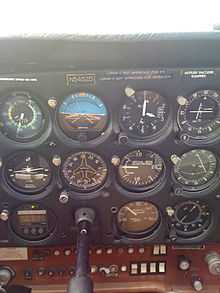
In 1929, Jimmy Doolittle became the first pilot to take off, fly and land an airplane using instruments alone, without a view outside the cockpit. In 1937 the British Royal Air Force (RAF) chose a set of six essential flight instruments[1] which would remain the standard panel used for flying in instrument meteorological conditions (IMC) for the next 20 years. They were:
- altimeter (feet)
- airspeed indicator (knots)
- turn and bank indicator (turn direction and coordination)
- vertical speed indicator (feet per minute)
- artificial horizon (attitude indication)
- directional gyro / heading indicator (degrees)
This panel arrangement was incorporated into every RAF aircraft, from the light single-engined Tiger Moth trainer to the 4-engined Avro Lancaster heavy bomber, and minimized the type-conversion difficulties associated with blind flying, since a pilot trained on one aircraft could quickly become accustomed to any other if the instruments were identical.
This basic six set, also known as a "six pack",[2] was also adopted by commercial aviation. After the Second World War the arrangement was changed to: (top row) airspeed, artificial horizon, altimeter, (bottom row) turn and bank indicator, heading indicator, vertical speed.
Further development
Of the old basic six instruments, the turn and bank indicator is now obsolete. The instrument was included, but it was of little use in the first generation of jet airliners. It was removed from many aircraft prior to glass cockpits becoming available. With an improved artificial horizon, including gyros and flight directors, the turn and bank indicator became needless. But the other five flight instruments, sometimes known as "the big five", are still included in all cockpits. The way of displaying them has changed over time, though. In glass cockpits the flight instruments are shown on monitors. But the display is not shown by numbers, but as images of analog instruments. The artificial horizon is given a central place in the monitor, with a heading indicator just below (usually this is displayed only as a part of the compass). The indicated airspeed, altimeter, and vertical speed indicator are displayed as columns with the indicated airspeed and altitude to the right of the horizon and the vertical speed to the left in the same pattern as in most older style "clock cockpits".
Different significance and some other instrumentation
However, all five instruments are not equally important (in good weather conditions small aircraft can be landed without the use of any instrument, called visual landing.) Only the artificial horizon, altimeter, airspeed indicator and compass are imperative. Due to this all passenger airliners are equipped with a battery-powered integrated standby instrument system along with a magnetic compass.
The vertical speed indicator, or VSI, is more of "a good help" than absolutely essential. On jet aircraft it displays the vertical speed in thousands of feet per minute, usually in the range -6 to +6. The gyrocompass can be used for navigation, but it is indeed a flight instrument as well. It is needed to control the adjustment of the heading, to be the same as the heading of the landing runway. Indicated airspeed, or IAS, is the second most important instrument and indicates the airspeed very accurately in the range of 45 to 250 knots. At higher altitude a MACH-meter is used instead, to prevent the aircraft from overspeed. An instrument called true airspeed, or TAS, exists on some aircraft. TAS shows airspeed in knots in the range from 200 knots and higher (It is like the Mach-meter: not really a flight instrument). The altimeter displays the altitude in feet, but must be corrected to local air pressure at the landing airport. The altimeter may be adjusted to show an altitude of zero feet on the runway, but far more common is to adjust the altimeter to show the actual altitude when the aircraft has landed. In the latter case pilots must keep the runway elevation in mind. However a radio altimeter (displaying the height above the ground if lower than around 2000–2500 feet) has been standard for decades. This instrument is however not among the "big five", but must still be considered as a flight instrument.
See also
References
- ↑ "Instrument Planning The New Service Blind-Flying Panel Described" Flight August 19, 1937 p193
- ↑ "Six Pack - The Primary Flight Instruments". LearnToFly.ca. Retrieved 31 January 2011.
External links
- Instrument Flying Handbook 2012
- Pilot's Handbook of Aeronautical Knowledge (FAA-H-8083-25A) 2008
- The Gyro Horizon Enables Instrument Flying A history of how aircraft instrumentation was developed with an emphasis on the gyro horizon. 2007
- "How Aircraft Instruments Work." Popular Science, March 1944, pp. 116–123/192.
| ||||||||||||||||||


